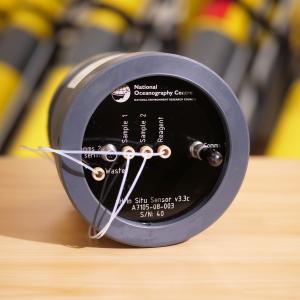NOC has developed an integrated microfluidic lab-on-chip system to measure pH, which is one of the first of its kind employing microfluidics for autonomous oceanographic measurements. It utilises the standard spectrophotometric analytical method offering high accuracy (<0.005) and precision (<0.001) pH measurements for ocean acidification research. It can be deployed for periods of longer than a year on autonomous platforms measuring at a maximum frequency of 6hrs-1. It has low power consumption and can be powered by either on-board batteries or an external power source. High performance electronics and communication systems allow on-board data processing and output of temperature and salinity corrected pH measurements. Pressure tolerant components allow deployments at a depth of 6000 metres.
The pH sensor has competed at the Wendy Schmidt Ocean Health XPRIZE competition reaching the semi-final stage. Since then it has been deployed at the Gullmar Fjord capturing the daily variation in pH caused by biological processes including primary production and respiration. The pH sensor has also been deployed in Southampton waters on several occasions mainly for testing and optimisation work. Most recently the sensor has been used for coral reef monitoring in the Seychelles, CCS storage site monitoring in the North Sea and long term pH monitoring in Germany.

